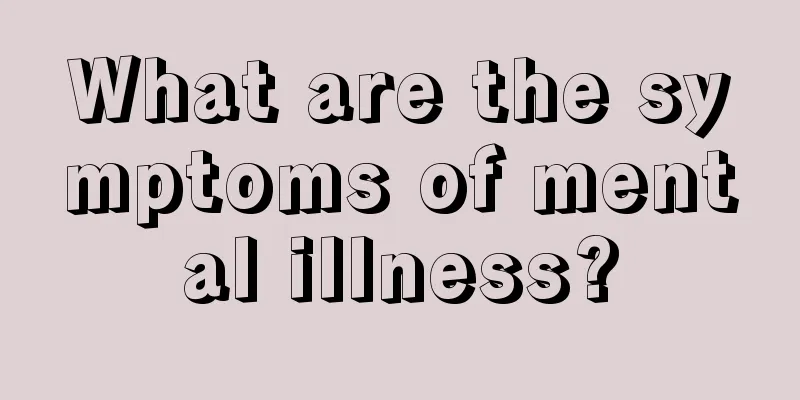What are the symptoms of mental illness?

|
Mental illness is a kind of pathology. It is very common in modern society. It just exists to different degrees. Everyone will encounter it. For example, a broken heart, failure in an exam, the departure of loved ones, interpersonal relationships, etc. can all cause mental disorders. A bad mood over a period of time can cause a loss of interest, disrupted life patterns, and even abnormal behavior and personality deviation, etc. These are all mental illnesses. Adults, children, and the elderly may experience this condition, so we must pay more attention to it. So what are the common symptoms? 1. Illusion This is a distorted feeling of objective things, that is, perceiving something that exists in the objective external world as another thing with completely different properties. Once an illusion occurs, the patient himself cannot detect it. It cannot be recognized, let alone corrected, and it seriously affects the patient's behavior. For example, the patient may mistake the white rice in the bowl for maggots and become furious; he may mistake the kitten on the roof for a tiger, or the suspended ceiling for a python and become terrified. 2. Hallucinations This is a kind of illusory perception and experience that occurs when there is no real stimulus acting on the corresponding sensory organs. That is, a certain thing does not exist in the external environment, but the subject insists on perceiving the existence of that thing. Therefore, it is a false and illusory perception that comes out of nothing. Hallucinations include auditory hallucinations, visual hallucinations, taste hallucinations, olfactory hallucinations, tactile hallucinations, etc. The patient may be completely attracted by the hallucinations, controlled by the hallucinations, and exhibit various abnormal behaviors. For example, some patients may hear voices "commanding" them to burn their belongings or throw away their money, "threatening" them to beat people to death, etc. Under the influence of this hallucination, the patient may actually set fire to his or her own belongings, throw away money, or attempt suicide because he or she cannot bear the threat. 3. Delusion This is a morbid idea that has no factual basis but the patient is unshakable. It is a distorted belief, wrong judgment and reasoning. Such as hypochondriacal delusions, relationship delusions, erotomania, persecution delusions, jealousy delusions, etc. The patient is suspicious of the things around him or exaggerates his own abilities, status and property. Although such ideas are extremely absurd and have no factual basis at all, the patient firmly believes in them. No matter how others explain, even if they put irrefutable facts in front of him, it is impossible to shake or correct his wrong beliefs and ideas. For example, some patients firmly believe that they have an incurable disease, such as brain atrophy, heart arrest, lung or stomach rot, etc. Although the doctor has repeatedly and carefully examined and proved that this type of disease does not exist, the patient still firmly believes in it and is anxious, worried and lamenting all day long, thinking that he has no hope of living. 4. Excitement This refers to the patient's emotional agitation, increased activity, irritability, incessant talk, restlessness, and sometimes impulsive and destructive behavior such as hurting people and destroying things. 5. Melancholy This refers to the patient being depressed, frustrated, frowning and sighing all day long, and being indifferent and not interested in the things around him. Such patients have thoughts of self-blame and guilt, are pessimistic and hopeless, and may even have suicidal thoughts and behaviors. 6. Stupor The patient is almost motionless, does not speak or move, does not eat or drink, and often maintains a fixed posture, sitting stiffly or lying straight in bed all day. He reacts slowly or does not react at all to external stimuli. Even if someone beats drums and gongs in his ears, he remains indifferent, like a "wooden man". 7. Delirium This is a symptom that occurs in patients with acute brain injury, which is mostly caused by infection and toxic diseases. The patient is delirious, talking nonsense, restless, does not recognize the people and objects around him, and often has terrifying hallucinations. For example, some patients in a delirious state say that they saw people who had been dead for many years or saw ferocious, hideous monsters who wanted to take him away, so they cried loudly and were terrified. dementia This is a symptom of chronic brain damage. The patient's intelligence and memory are significantly reduced, and he loses normal comprehension, judgment, and calculation abilities. |
<<: Is intravenous infusion effective for treating toothache?
>>: Bitter mouth and dry throat. 7 types of breath in the morning are signs of physical illness
Recommend
Can molluscum contagiosum be cured?
Molluscum contagiosum is caused by a viral infect...
What are the folk remedies for treating late-stage liver disease? What is the best diet for late-stage liver cancer?
The lesions of patients with advanced liver cance...
What are the treatments for rectal cancer?
Because our unreasonable eating habits are the ma...
Pathological classification of prostate cancer
Prostate cancer mainly occurs in men over 50 year...
The difference between Astragalus and Astragalus Extract
If you have some knowledge about Chinese medicine...
What is the postoperative care for osteosarcoma patients
For osteosarcoma, a disease with a low incidence ...
How long does it take to recover from a fracture?
Many people will experience bone fractures in lif...
Have you ever been checked for prostate cancer?
Prostate cancer is the most common malignant tumo...
Should I wash the conditioner thoroughly?
Conditioner may be a little unfamiliar to boys, b...
Dark red mucous blood in stool
Although bleeding in the stool is something that ...
Can lung cancer turning into bone cancer be cured?
Can lung cancer metastasize to bone cancer be cur...
Symptoms of brain cancer in women
The brain is one of the most important organs of ...
Can I exercise during uterine cancer?
After undergoing endometrial cancer surgery, you ...
Tips for removing scale from your pool
Whether it is in the kitchen or the bathroom, I b...
Bone age testing, a deeper understanding of yourself
Bone age testing is a method of detecting age. Ex...









